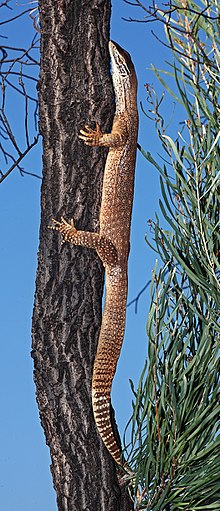Sand goanna
| Sand goanna | |
|---|---|

| |
| Gould's monitor or sand goanna in the Tanami Desert | |
| Scientific classification | |
| Kingdom: | |
| Phylum: | |
| Subphylum: | |
| Class: | |
| Order: | |
| Suborder: | |
| Family: | |
| Genus: | |
| Subgenus: | V. (Varanus)
|
| Species: | V. gouldii
|
| Binomial name | |
| Varanus gouldii (Gray, 1838)
| |

| |
| Distribution of the Sand goanna | |
The sand goanna (Varanus gouldii ) is a species of large Australian monitor lizard, also known as Gould's monitor, the sand monitor, or racehorse goanna.[1]
In some Aboriginal languages, the sand goanna is called bungarra,[2] a term commonly used by nonaboriginal people in Western Australia, too.
The name "sand monitor" can be used to describe various other species.
Etymology
The specific name, gouldii, is a Latinized form of the name of the scientist who first described this species, English ornithologist John Gould.[3]
Biology
Gould's monitor is a terrestrial or "ground-dwelling" reptile that excavates large burrows for shelter. Rock escarpments and tree hollows are also suitable dwellings. V. gouldii inhabits a vast range throughout Australia, and reaches an average length of 140 cm (4.6 ft) and can weigh as much as 6 kg (13 lb). They can be found in northern and eastern Australia, where they inhabit open woodlands and grasslands. V. g. flavirufus, a slightly smaller subspecies, resides in Australia's interior. In some places, however, the ranges of Gould's, V. g. flavirufus and the Argus monitor overlap. The similarities between the species and their close proximity frequently cause confusion.
The sand monitor is a relentless forager. It is diurnal, meaning most of its activities take place during the day. Anything smaller than itself will be eagerly devoured. The diets of hatchlings and juveniles often consist mostly of insects and small lizards, but generally varies more with age. Adult monitors will prey on mice, small birds large insects, small lizard species, snakes, and carrion. They are seemingly immune to snake venom and will kill and eat even the most venomous species such as the fierce snake. The sand goanna does consume smaller species of monitors: Ackies, rock monitors and other dwarf species are often found and eaten. It is common to see a Gould's disturbing rock piles in an attempt to flush out any Odatria. It lays its eggs in termite mounds to protect them from the harsh desert climate.
Like all goannas and snakes the sand monitor has a forked tongue, with which it "tastes" the air. Scents are picked up on each side of the fork which, when retracted, brushes over an area in the mouth called the Jacobson's organ, which identifies on which side the scent is stronger. Upon identifying this difference in scent strength the sand monitor can alter its direction accordingly.
Subspecies
- Gould's goanna - V. g. gouldi
- Desert sand monitor - V. g. flavirufus
References
- ^ http://www.wildherps.com/species/V.gouldii.html
- ^ Flora and fauna of Australia’s West Pilbara Coast Karratha Visitor Centre website, accessed: 30 July 2012
- ^ Beolens B, Watkins M, Grayson M. 2011. The Eponym Dictionary of Reptiles. Baltimore: Johns Hopkins University Press. xiii + 296 pp. ISBN 978-1-4214-0135-5. (Varanus gouldii, p. 104).
Sources and photos
- Photo of Varanus gouldii at AROD.com.au
- Photo of Varanus gouldii at Pbase.com
- Cogger, H. (1967). Australian Reptiles in Colour. Sydney: A. H. & A. W. Reed, ISBN 0-589-07012-6
- King, Dennis & Green, Brian. 1999. Goannas: The Biology of Varanid Lizards. University of New South Wales Press. ISBN 0-86840-456-X
- Brian Bush, Brad Maryan, Robert Browne-Cooper and David Robinson,(1995) A guide to the reptiles and frogs of the Perth region, Nedlands. UWA Press. ISBN 1-875560-42-4
- Thompson (1995). "Foraging patterns and behaviours, body postures and movement speed for goannas, Varanus gouldii (Reptilia: Varanidae),
in a semi-urban environment." G. G. Thompson. Journal of the Royal Society of Western Australia, 78 (4), December 1995, pp. 107–114.
-
Sand monitor walking tracks in sand.
-
Bungarra at the Gidgee Gold Mine.
-
Bungarra at the Sunrise Dam Gold Mine.
-
South-west Western Australia
-
Chace ranges, South Australia





